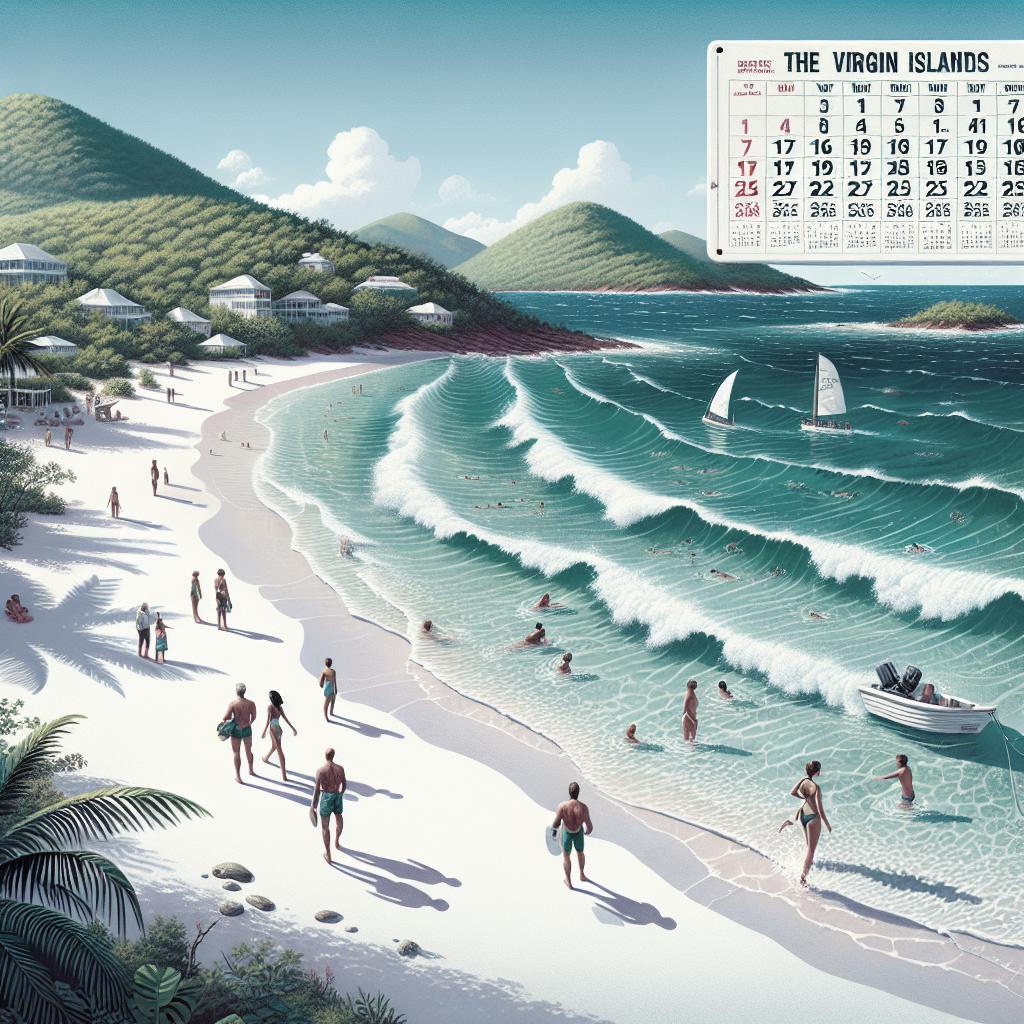The U.S. Virgin Islands are a tropical paradise beloved by travelers worldwide. With its stunning beaches, clear blue waters, and vibrant culture, it’s no wonder you might be considering a trip there. But when is the best time to visit? This comprehensive guide will break down what to expect each month, taking into account weather, tourist seasons, and key holidays and events. Whether you’re looking for a serene escape or a lively adventure, this detailed overview will help you plan your ideal getaway to the U.S. Virgin Islands.
Weather in the US Virgin Islands
The U.S. Virgin Islands experience a tropical climate, characterized by warm weather year-round. Temperatures generally hover between 77°F (25°C) and 88°F (31°C), making it an ideal destination for those seeking warmth. The rainy season runs from June through November, with September and October being the wettest months. Conversely, the months from December to April are considered the dry season, bringing less rain and lower humidity. The consistent trade winds provide a gentle cooling effect, meaning even in the hottest months, the islands are comfortable. However, it’s essential to consider the Atlantic hurricane season, which officially spans from June to November. While hurricanes are not guaranteed, they are a possibility, adding an element of unpredictability to visits during these months.
Peak Tourist Season in the U.S. Virgin Islands
The peak tourist season in the U.S. Virgin Islands is from December to April. This is when weather conditions are most favorable, characterized by sunny days, minimal rain, and pleasantly warm temperatures. During these months, the islands are bustling with tourists, leading to higher prices for accommodations and activities. Popular areas can become crowded, but the lively atmosphere can be exciting. If you prefer a quieter experience, consider visiting during the shoulder seasons, which fall just outside the peak months. Late April to early June and November can offer a balance of decent weather and fewer crowds.
Key Holidays & Events in the U.S. Virgin Islands
The U.S. Virgin Islands host numerous events throughout the year that can significantly enhance your travel experience. The St. Thomas Carnival in April is one of the most prominent, featuring parades, music, and local cuisine. Thanksgiving weekend in November sees the Cultural Day at Emancipation Garden, celebrating local heritage and customs. Heading into the year-end, December hosts the Miracle on Main Street festival, lighting up downtown Charlotte Amalie with holiday cheer. These events are excellent opportunities to immerse yourself in the local culture and traditions, but they can also draw large crowds, so plan accordingly.
January
January is a fantastic time to visit the U.S. Virgin Islands. It falls within the dry season, with less rain and optimal weather conditions. The temperatures are pleasantly warm, and the seas are calm, making it perfect for beach activities and water sports. Moreover, January is part of the peak tourist season. While it will be more crowded and expensive, the vibrant atmosphere is memorable. Be sure to book accommodations and activities well in advance to secure your spot.
February
February continues the trend of excellent weather initiated in January. It’s one of the driest months, offering plenty of sunshine and warm temperatures. The steady trade winds make it great for sailing and other marine activities. Since it is still peak tourist season, anticipate bustling beaches and busy streets. Planning ahead is essential for making the most out of your trip. Capture the essence of island life by strolling through local markets and experiencing the unique culture.
March
March marks the continuing peak tourist season, blending fantastic weather with vibrant island life. The atmosphere is lively, with many visitors taking advantage of spring break to escape to the islands. The seas remain calm, ideal for snorkeling and diving. If you enjoy local events, March often hosts Food Fairs that celebrate island culinary traditions. This month is perfect for vacationers looking to combine excellent weather with rich cultural experiences.
April
April is the last month of the peak tourist season, featuring stellar weather and reduced rainfall. The St. Thomas Carnival is a highlight of this month, offering a deep dive into local culture with its colorful parades and musical performances. However, as April progresses, tourism starts to dwindle, allowing for a less crowded experience. This makes April an excellent month to enjoy both the festive atmosphere and a hint of tranquility.
May
May is a transitional month, bridging the gap between the peak season and the rainy season. While there is a slight increase in rainfall, it’s still relatively low, and the islands are less crowded. This results in better availability and lower prices for accommodations. The weather remains warm, making it a pleasant time for outdoor activities. May is ideal for those looking to experience the beauty of the Virgin Islands without the hustle and bustle of peak tourist months.
June
June officially marks the beginning of the rainy season and the hurricane season. Despite the increased rainfall, there are still many sunny days, and the tourism crowds are significantly reduced. This can be a boon for travelers on a budget as prices for flights and hotels drop. However, it’s crucial to keep an eye on weather forecasts. While the risk of hurricanes is relatively low this early in the season, it’s best to be prepared for some tropical showers.
July
July continues the rainy season with a mixture of sunny and wet days. The temperatures can get quite warm, but the trade winds help keep the climate enjoyable. This is also one of the best months for marine activities, as the sea life is more abundant. Given that it falls within the summer vacation window, you might encounter more families but fewer overall tourists compared to peak season. This balance makes July a versatile month for different types of travelers.
August
August is in the heart of the hurricane season, bringing increased rainfall and a higher likelihood of storms. The tourist footfall is low, making it one of the least crowded times of the year. Hotel rates are generally the most economical during this time. While the weather can be unpredictable, those willing to take the risk might find a peaceful and budget-friendly getaway. Just remember to have flexible plans in case of weather disruptions.
September
September is traditionally the peak of the hurricane season. The island’s tourism sees a steep decline, and many businesses, including some hotels and restaurants, may close temporarily. Heavy rains are common, and the weather can be highly unpredictable. For most travelers, this is not an ideal month to visit. However, if you’re an adventurer seeking solitude and are prepared to navigate potential weather interruptions, the serene beaches are all yours.
October
October remains within the hurricane season but usually features fewer storms compared to September. Tourism is still at a low point, resulting in some of the best deals for accommodations and activities. The weather begins to stabilize, offering more sunny days. This month can be a hidden gem for budget-conscious travelers willing to take a slight risk. Expect fewer crowds and a more intimate experience with the islands’ natural beauty.
November
November marks the beginning of the dry season and the end of hurricane season. The weather begins to turn more favorable, with decreasing rainfall and increasing sunshine. It’s also when the tourist season starts to pick up, especially towards the month’s end. Key events like Thanksgiving and the Virgin Islands Cultural Day make November an exciting month to visit. You can enjoy cultural festivities and experience the islands coming back to life after the slower season.
December
December kicks off the peak tourist season with fabulous weather and a festive atmosphere. The earlier part of the month might still offer some lower rates, but as the holidays approach, prices and tourist numbers surge. Events like the Miracle on Main Street add a special holiday charm to the islands. With abundant sunshine and minimal rain, December is perfect for a holiday escape to the Caribbean. “`
| Month | Weather & Climate | Tourist Activity | Key Events |
|---|---|---|---|
| January | Dry season, warm and sunny | Peak tourist season | No major events |
| February | Dry season, excellent weather | High tourist activity | No major events |
| March | Dry, warm, and sunny | Peak tourist season, spring break crowd | Food Fairs |
| April | Dry season, excellent weather | End of peak season | St. Thomas Carnival |
| May | Transitional, slight increase in rain | Less crowded | No major events |
| June | Start of rainy & hurricane season | Low tourist activity | No major events |
| July | Rainy season, warm | Moderate tourist activity | No major events |
| August | Peak hurricane season, wet | Least crowded, low prices | No major events |
| September | Peak hurricane season, heavy rain | Very low tourist activity | No major events |
| October | End of hurricane season, mixed weather | Low tourist activity | No major events |
| November | Start of dry season, favorable weather | Increasing tourist activity | Thanksgiving, Cultural Day |
| December | Dry season, sunny and warm | High tourist activity | Miracle on Main Street |
“` In summary, the best time to visit the U.S. Virgin Islands largely depends on what you’re seeking. For perfect weather and vibrant social scenes, the peak tourist season from December to April is ideal. However, if you want a quieter and more budget-friendly experience, the shoulder seasons of late April to early June and November offer a pleasant compromise. Always keep an eye on weather forecasts, particularly during the hurricane season, to ensure a safe and enjoyable trip.

